


Brougham Hall is located in the village of Brougham just outside Penrith, Cumbria, England.



Brougham Hall is located in the village of Brougham just outside Penrith, Cumbria, England.
The de Burgham family may have held land at Brougham in Edward the Confessor's time and were allowed to keep their position after the Norman Conquest of England, which occurred after 1092 in this region : a Wilfred de Burgham was recorded in the reign of Henry II. The de Burghams retained land by military service to the Vieuxpont lords who lived at Brougham Castle close by. [1]
The hall, usually sold in third parts, passed through the hands of various families in Medieval times. Lady Anne Clifford, 14th Baroness de Clifford, the then owner of Brougham Castle, bought one third part of Brougham Hall in 1654. Amongst other improvements, she re-built the Hall's chapel, St. Wilfrid's, completed about 1659. Lady Anne's attorney-at law and later her steward, James Bird, bought her third of the Hall and manor after her death (1676), being the first person to hold the entirety of the building since the de Broughams. [2] The male line of the Birds of Brougham family died out, however, and the then owner of the Hall and estate, Thomas Carleton, sold both to John Brougham of Scales in 1726. John Brougham belonged to a separate branch of the old de Brougham family, and was "the most successful member of the Brougham family in the 18th century", being a Commissioner in the Excise service for England as well as a barrister and local squire. [3]
The oldest part of the hall is the thirteenth-century gateway, followed by the Tudor Hall, which dates back to around 1480–1520. [4] The seventeenth-century guardhouse was built by James Bird. The Hall was close to the scene of a bloody battle between the Jacobite army of Prince Charles Edward Stuart and Government forces (the Clifton Moor Skirmish), that took place in December 1745.
The rise to power of Henry Brougham, 1st Baron Brougham and Vaux, led to the Hall being extended and enlarged between 1830 and 1847, to designs by the architect Lewis Nockalls Cottingham. The building works were largely overseen by Henry's brother, William Brougham, 2nd Baron Brougham and Vaux. [5]
From this point on, Brougham Hall received visits from London " society" and other notable people, including royalty. This culminated in the visit, in 1905, of the King, Edward VII. [6] However, after World War I, Brougham Hall, in common with many other country houses, faced a severe financial crisis. This was compounded by the spendthrift nature of Victor Brougham, 4th Baron Brougham and Vaux, and his failed attempts to shore up income by becoming a professional gambler. [7] The hall was sold by Victor, 4th Baron Brougham, attempting to pay his many debts, in 1934, and was thereafter sold again for demolition.
From 1941 to 1945, there was a secret tank development facility at Brougham Hall. The project was known as Canal Defence Light (CDL). A plaque at the Hall remembers the men who worked there during the war. There is also a bunker which was used during World War II. [8]
After World War II, the Hall languished in a derelict state until it was purchased by Christopher Terry in 1967. Mr. Terry and his wife, Alison, determined to arrest the further decline of the Hall. [9]
Today, the hall is the subject of a renovation project by volunteers and is open to visitors throughout the year. [10]

Sizergh Castle and Garden is a stately home and garden at Helsington in the English county of Cumbria, about 4 miles (6 km) south of Kendal. Located in historic Westmorland, the castle is a grade I listed building. While remaining the home of the Hornyold-Strickland family, the castle with its garden and estate is in the care of the National Trust.

Henry Peter Brougham, 1st Baron Brougham and Vaux, was a British statesman who became Lord High Chancellor and played a prominent role in passing the 1832 Reform Act and 1833 Slavery Abolition Act.
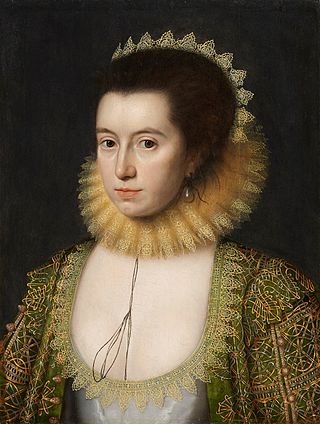
Lady Anne Clifford, Countess of Dorset, Pembroke and Montgomery, suo jure 14th Baroness de Clifford was an English peeress. In 1605 she inherited her father's ancient barony by writ and became suo jure 14th Baroness de Clifford. She was a patron of literature and as evidenced by her diary and many letters was a literary personage in her own right. She held the hereditary office of High Sheriff of Westmorland which role she exercised from 1653 to 1676.
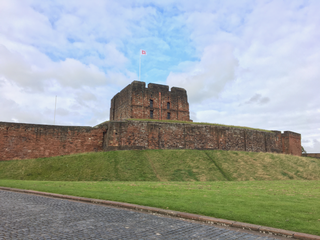
Carlisle Castle is a medieval stone keep castle that stands within the English city of Carlisle near the ruins of Hadrian's Wall. First built during the reign of William II in 1093 and rebuilt in stone under Henry I in 1122, the castle is over 900 years old and has been the scene of many episodes in British history. Given the proximity of Carlisle to the border between England and Scotland, it has been the centre of many wars and invasions. During the Jacobite Rising of 1745–6, Carlisle became the last English fortress to undergo a siege. The castle was listed as a Scheduled Ancient Monument on 7 August 1996.

Lanercost Priory was founded by Robert de Vaux between 1165 and 1174, the most likely date being 1169, to house Augustinian canons. The priory is situated at the village of Lanercost, Cumbria, England, within sight of Naworth Castle, with which it had close connections. The Lanercost Chronicle, a thirteenth-century history of England and the Wars of Scottish Independence, was compiled by the monks of the priory.

Sir George Clifford, 3rd Earl of Cumberland, 13th Baron de Clifford, 13th Lord of Skipton,, was an English peer, naval commander, and courtier of Queen Elizabeth I of England. He was notable at court for his jousting, at the Accession Day Tilts, which were highlights of the year at court. Two famous survivals, his portrait miniature by Nicholas Hilliard and a garniture of Greenwich armour, reflect this important part of his life. In contrast, he neglected his estates in the far north of England and left a long succession dispute between his heirs.

Brougham is a small village and civil parish on the outskirts of Penrith in the Eden District of Cumbria, England. According to the 2001 census the parish had a population of 279, falling marginally to 277 at the 2011 Census.

Muncaster Castle is a privately owned castle overlooking the River Esk, about a mile east of the west-coastal town of Ravenglass in Cumbria, England. It is recorded in the National Heritage List for England as a designated Grade I listed building.
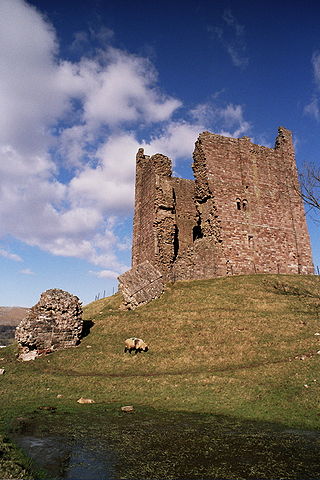
Brough Castle is a ruined castle in the village of Brough, Cumbria, England. The castle was built by William Rufus around 1092 within the old Roman fort of Verterae to protect a key route through the Pennine Mountains. The initial motte and bailey castle was attacked and destroyed by the Scots in 1174 during the Great Revolt against Henry II. Rebuilt after the war, a square keep was constructed and the rest of the castle converted to stone.
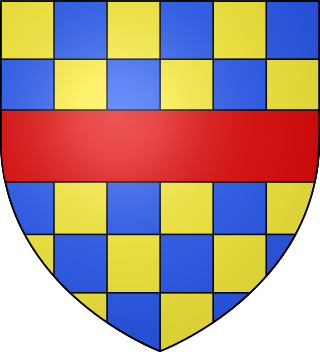
Robert de Clifford, 1st Baron de Clifford, of Appleby Castle, Westmorland, feudal baron of Appleby and feudal baron of Skipton in Yorkshire, was an English soldier who became 1st Lord Warden of the Marches, responsible for defending the English border with Scotland.

High Head Castle is a large fortified manor house in the English county of Cumbria. It is located between Carlisle and Penrith. The house is now largely a ruin with the exterior walls and certain foundations surviving for the majority of the building. The right hand wing of the building has had a roof re-instated, and may be usable again for the first time since the building burnt down in the 1950s. It is currently not open to the public. It is privately owned, and the owners have now for some time been trying to restore it to its former glory.
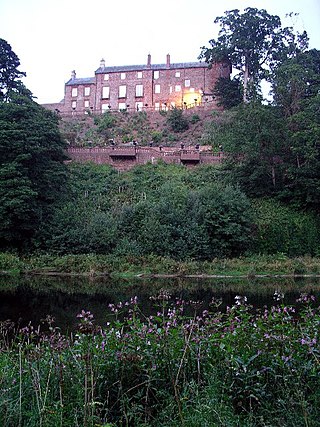
Corby Castle is an ancestral home of the Howard family situated on the southern edge of the village of Great Corby in northern Cumbria, England.

Brougham Castle is a medieval building about 2 miles (3.2 km) south-east of Penrith, Cumbria, England. The castle was founded by Robert I de Vieuxpont in the early 13th century. The site, near the confluence of the rivers Eamont and Lowther, had been chosen by the Romans for a Roman fort called Brocavum. The castle, along with the fort, is a scheduled monument: "Brougham Roman fort and Brougham Castle".
Westmorland in North West England was abolished in 1974 following Ted Heath's Local Government Act 1972. Westmorland became a part of Cumbria along with Cumberland, parts of Yorkshire and Lancashire, including the Furness peninsular. In 2022 Westmorland was reconstituted as Westmorland and Furness following the abolition of Cumbria County Council. Westmorland and Furness have no High Sheriff as Cumbria has remained the ceremonial county.
James Brougham was a British Whig politician.

Ninekirks is the local name for St Ninian's church, Brougham, Cumbria. Dedicated to Saint Ninian, it was formerly the Anglican parish church for Brougham, a parish which is now combined with Clifton, a neighbouring village. It is preserved as a redundant church for its architectural interest, and presents a mainly seventeenth-century appearance. It has been known as Ninekirks since at least 1583.
Vipont is the name of a prominent family in the history of Westmorland. According to Thomas the name originated in France before 1066 as Vieuxpont, Latinized to de Vetere Ponte, with alternative spellings Vezpont, Veepon, Vexpont, Vypont, Vispont, Vypunt, Vespont, Vipond, Vypond, Voypond, Veepond, Vippond, Vipon, Vipan, Vipen, etc. The Vipont family bore arms: Gules, six annulets or 3:2:1, later quartered by Baron Clifford.
William Brougham, 2nd Baron Brougham and Vaux, known as William Brougham until 1868, was a British barrister and Whig politician.

Caludon Castle is a Scheduled Ancient Monument and Grade I listed building in Coventry, in the West Midlands of England. A second moated site 190 metres (620 ft) to the south is a Scheduled Ancient Monument in its own right. The castle is now a ruin, and all that remains is a large fragment of sandstone wall. What remains of the estate is now an urban park, owned and run by Coventry City Council, but much of it was sold and developed into housing estates in the early 20th century.

William Greystoke, 2nd Baron Greystoke, of Greystoke in Cumbria, was an English peer and landowner.